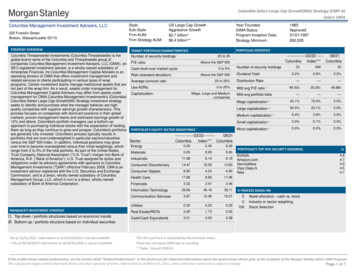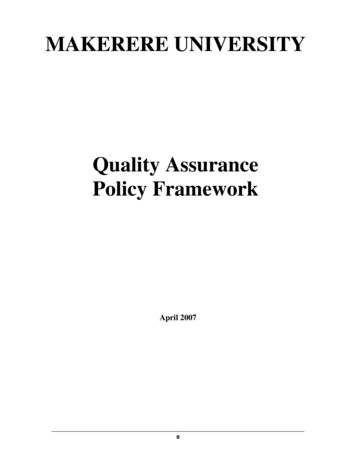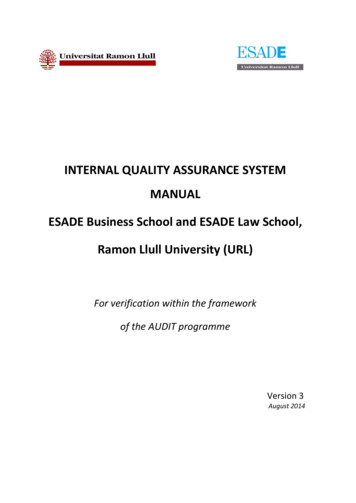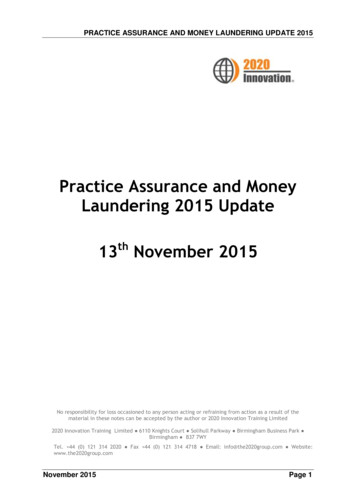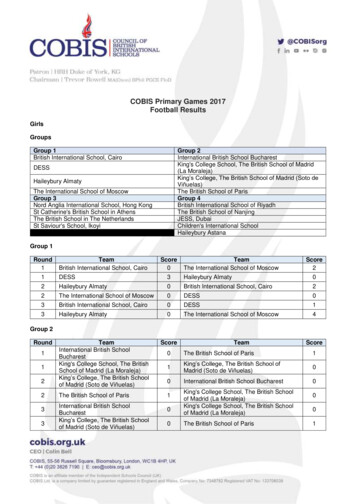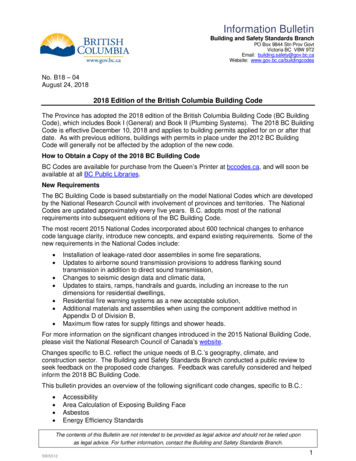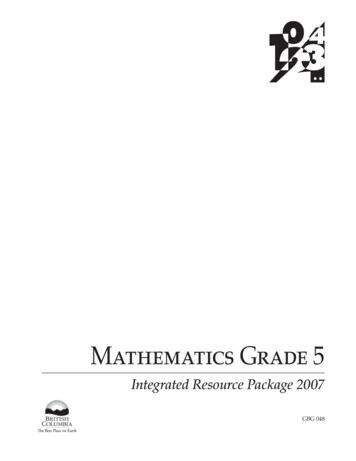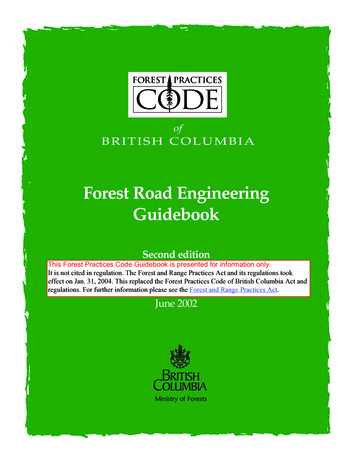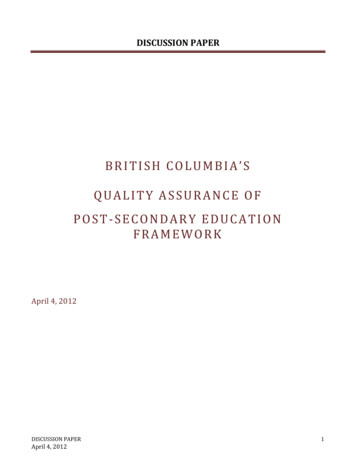
Transcription
DISCUSSION PAPERBRITISH COLUMBIA’SQUALITY ASSURANCE OFPOST‐SECONDARY EDUCATIONFRAMEWORKApril 4, 2012DISCUSSION PAPERApril 4, 20121
DISCUSSION PAPERINTRODUCTIONBritish Columbia’s integrated post‐secondary education system offers a range of education and training options forstudents. The current quality assurance system served British Columbia well when the province had a smaller,less diverse post secondary education system. The province’s post secondary system has evolved and grown incomplexity. In response, BC’s quality assurance processes must adapt.Strengthening quality assurance standards and processes are needed to ensure that students receive the bestpossible education and that employers can have confidence in the quality of education provided to their current orpotential employees. The public also needs to be assured, given the substantial public investment in the system,that value for money is being achieved.Quick Facts – BC Post Secondary SystemThe Quality Assurance Framework outlines theplan for strengthening quality assurance acrossthe entire post‐secondary education system anddeveloping new standards that will apply to allinstitutions. A system of quality assurance thatis fair, accountable, transparent and strong,following internationally recognized standardsand practices, will ensure that BC’s reputationfor excellence in post‐secondary education ismaintained and enhanced. The framework willbe used to create a new Quality Assurance Act forall post‐secondary institutions deliveringeducation in or from BC.The framework also takes into account previousreports on the quality of post‐secondaryeducation commissioned by the Ministry ofAdvanced Education as well as national andinternational commitments: Public Post‐secondary Institutions consisting of 11universities, 11 colleges and three institutes. Theseinstitutions have over 440,000 students offering1,900 educational and training programs. 17 Private and Non‐BC Public Post‐secondaryDegree Granting Institutions with approximately7,400 students taking 66 programs. Approximately 340 Private Career TrainingInstitutions with over 51,000 enrolments inapproximately 2,900 programs. 13 Private Post‐secondary Theological Institutionsoffering credentials in theological education only. An unknown number of private post‐secondaryacademic (non‐degree granting), private languageschools and on reserve Aboriginal Schools which donot fall under provincial legislation. Private Career Training Institutions Act Review (Watson Report) ‐ An independent review of the PrivateCareer Training Institutions (PCTI) Act was undertaken in the summer and fall of 2007. In addition toenhancing outcomes based quality assurance and institutional commitment to continuous improvement, thefinal report recommended streamlining policies, procedures and practices between the PCTI Act and theDegree Authorization Act and exploring the potential for a single act. Degree Process Review Report (Stubbs Report) – An independent review of the degree approval processwas undertaken in 2011. Through extensive consultation with stakeholders the report provided 35recommendations with the themes of greater transparency, data collection, process improvements, systemcoordination and periodic institution reviews. Canadian Degree Qualifications Framework (2007) ‐ Council of Ministers of Education, Canada (CMEC)The framework describes degree categories and sets out degree‐level standards. This framework providesa context for identifying how degree credentials compare in level and standard among jurisdictions, with aview to facilitating continuous improvement, the education and training of an internationally competitiveDISCUSSION PAPERApril 4, 20122
DISCUSSION PAPERworkforce, and international recognition of the quality of Canadian credentials. Organization for Economic Co‐operation and Development (OECD)/United Nations Educational Scientificand Cultural Organization (UNESCO) Guidelines for Quality in Cross‐Border Education (2005) – TheGuidelines provide an international framework to protect students and other stakeholders from low‐quality provision from providers engaged in cross‐border education. As Canada is a member of theOrganization for Economic Co‐operation and Development there is an expectation that all countries thatadopted the guidelines abide by them.The following goals and objectives have been identified as key elements for improving the quality assurance ofpost‐secondary education in British Columbia.QUALITY ASSURANCE FOR THE FUTUREExcellence in quality learningoutcomes for studentsStrong and consistent quality assurance standards and processes thatsupport a differentiated post‐secondary systemGOAL 1GOAL 2GOAL 3The post secondaryeducation systemenhances andmaintainsexcellenceStudents achieveappropriatelearning outcomesthrough qualitystandards that areunderstandableand transparentGovernmentexercises effectiveoversight of thepost secondarysystem that enablescontinuousimprovement andthe building of bestpracticesBuild on existing best practices and accountabilities for institutionsDISCUSSION PAPERApril 4, 20123
DISCUSSION PAPERGoal 1: Post secondary education system enhances and maintains excellenceObjective 1.1A quality assurance framework that encompasses all BC post‐secondary education providersBC’s post‐secondary education quality assurance system differs by type of institution and program. There is alsoa broad range in institutional and programmatic review practices across the system. External validation of thequality of programs and institutions provide assurance to students and the public that minimum standards havebeen met or exceeded.The Degree Quality Assessment Board oversees degree programs and the Private Career Training InstitutionsAgency regulates private career training institutions.“Quality – Regardless of the mode of delivery andIn addition, BC also has the Education Qualitythe type of institution, organization or businessAssurance (EQA) designation that signals to studentsproviding lifelong learning, individuals must bethat an institution’s program meets minimum qualityprovided with a learning experience that meets orassurance standards. Multiple bodies overseeing theexceeds provincial norms or standards for high‐quality assurance of the post‐secondary educationquality learning.”system has led to inconsistency in standards as well asregulatory gaps across the system. Consequently,A Guiding Principle from the Confederation ofstudents and other stakeholders have found it difficultUniversity Faculty Associations’ Campus 2020to compare institutions and programs.SubmissionTo protect students and the integrity of the system,the new quality assurance framework could encompass a broader range of educational providers such aslanguage schools and theological institutions.Questions:a) The Degree Process Review Report recommended that the principles identified below guide the degreeapproval process. Should similar principles be expanded to all programs to guide development of the newquality assurance framework? Approving degrees of quality that will be recognized nationally and internationally;Following approval practices that are consistent, equitable, transparent, accountable, affordable,efficient and effective;Ensuring, in so far as possible, that the degree program approval processes in BC are compatible withthose in other Canadian provinces.Ensuring due process while respecting institutional policies and procedures in a differentiated system;Supporting a post‐secondary system that is as seamless as possible and that enhances opportunities forlife‐long learning;Enabling institutions to balance autonomy over their degree program approval processes, withappropriate internal and external accountability mechanisms;Ensuring the integrity and reputation of the post‐secondary system by identifying and, if possible,minimizing the risks to sustainability and to student graduation in all degree programs approved.DISCUSSION PAPERApril 4, 20124
DISCUSSION PAPERb) What governance structure is needed to provide oversight for the new quality assurance framework?c) Many jurisdictions are moving to more inclusive oversight of all institutions that provide adult education.The Private Career Training Institutions Act Review recommended that all private English as Second Languageinstitutions be brought under the PCTIA Act. What would be an appropriate level of oversight for theseinstitutions?Objective 1.2The new framework establishes consistent quality standardsThe new quality assurance framework will build upon strengths and key features of the current framework aswell as on good institutional review practices and accountabilities at BC’s post‐secondary institutions.Questions:a) What standards and processes are critical for ensuring effectiveness and credibility of the qualityassurance framework?b) How can comparability of standards be achieved for BC’s differentiated post‐secondary system?Goal 2: Students achieve appropriate learning outcomes through quality standards that areunderstandable and transparentObjective 2.1Identify and demonstrate high quality outcomesArticulating, measuring and reporting outcomes provides increased accountability to students and their families,employers, the public, government and other stakeholders.Of increasing prominence are learning outcomes.“The quality assurance (QA) process should befounded on two premises:In British Columbia, post‐secondary institutions havetraditionally established the name and type of credential Institutions should be accountable for theawarded. The Canadian Degree Qualifications Frameworkextent to which students achieve thesets out degree‐level standards that institutions areoutcomes promised or implied in theirrequired to observe and the Degree Quality Assessmentprograms and advertising.Board confirms adherence to these standards through the Institutions must have a commitment toquality assurance process. At the diploma and certificatecontinuous improvement.”level, there are some expectations of what thosecredentials represent particularly in regulated professionsWatson Reportwhere competency‐based standards have been established.However, there still remains a large portion of programswhere there are no agreed upon standards on what those credentials represent or what the learning outcomesare. Greater consistency in learning outcomes across the entire system will make it easier for students andemployers to assess the value of these credentials.Qualifications Frameworks are used in other countries to outline the expected learning outcomes at eachqualification level. A qualifications framework will provide clarity to students, prospective employers and otherstakeholders on what students should know and be able to do by the end of a program regardless of where thestudent receives their education.DISCUSSION PAPERApril 4, 20125
DISCUSSION PAPERQuestions:a) How can learning outcomes be effectively measured?b) What other outcomes measure student experience and should be incorporated within the new qualityassurance framework?Objective 2.2Students and the public have access to readily accessible and easy to understand informationto make informed decisions on their education optionsStudents and families make large investments, both in time and financial resources in order to receive a post‐secondary education that meets their personal and career goals. To support their investment, they needinformation comparing programs and institutions. This information is currently limited. At present, the datacollected from the post‐secondary system do not aggregate to a comprehensive core of information. Currentlegislative changes to the School Act will allow the expansion of the Personal Education Number (PENs) toprivate institutions so that analysis and research on student trends and transitions can be completed for allstudents within the BC post‐secondary system. Consistent information collection of core data across thepost‐secondary system and making it available to the public is needed to help students make informed choices;provide information to stakeholders on the achievement of quality outcomes; and inform and assess publicpolicy. Access to high quality information will enable the post‐secondary education system and government tobe more responsive to the needs of students and employers.Questions:a) What information will be most useful to students when they are considering programs and/orinstitutions?b) What role do the institution and the Ministry have in ensuring students and the public have informationthat is readily available, comparable across institutions and easy to understand?c) What data is useful to the entire system in order to make it a better system?Goal 3: Government exercises effective oversight of the post secondary system thatenables continuous improvement and the building of best practicesObjective 3.1 Effective and balanced oversight of the post secondary education systemInitially, institutions and their programs will undergo a process that determines whether the institution orprogram has maintained and will continue to maintain quality. The depth of future reviews will be based on aninstitution’s track record of maintaining quality assurance standards. This approach allows for continuedmonitoring of the system while providing for reduced oversight of institutions that have demonstrated low risk.Questions:a) What checks and balances should be taken into account when determining the appropriate level ofoversight for institutions and programs to ensure maintenance of quality and continuous improvement?b) What key factors should be taken into consideration when determining whether an institution hasdemonstrated low risk?DISCUSSION PAPERApril 4, 20126
DISCUSSION PAPERObjective 3.2Safeguarding the reputation of BC’s post‐secondary education systemBC institutions are increasingly innovative in their delivery methods and increasingly entrepreneurial, offeringprograms to students in other countries, often throughinternational partnerships or consortia. These factors“A rigorous quality assurance process is critical tocreate pressure to ensure that all programs, regardlessensure the quality of degrees in BC is upheldof delivery method or where the program is offered,nationally and internationally. RUCBC wouldmeet the same high quality standards in order toemphasize the need to ensure a consistentsafeguard the EQA brand. Widely‐publicized incidentsprocess for the public and private sectors.”have had a damaging effect on the entire post‐secondary education system.Research Universities’ Council of British Columbiacomments during the Stubbs ReviewQuestions:a) How can high quality standards be assured forthe diversity of delivery modes (e.g., distance education) and collaborative arrangements (e.g., jointdegrees)?b) What institutional and government processes need to be in place to safeguard the reputation of BC’spost‐secondary education system?c) Do the guidelines in the OECD/UNESCO Guidelines for Quality in Cross‐Border Education, specificallythose for educational providers, comprise an appropriate baseline standard expected of institutionsengaging in delivering programs outside of BC?DISCUSSION PAPERApril 4, 20127
DISCUSSION PAPERGlossaryCareer Training – Under the Private Career Training Institutions Act career training is defined as credentials at thenon‐degree level, described in the National Occupational Classification scheme as an occupation where the tuitionis greater than or equal to 1,000 and the program is longer than or equal to 40 hours.Degree Quality Assessment Board (DQAB) ‐ The Degree Authorization Act establishes a quality assessment processfor degree approval (all institutions) and use of the term university (private and out of province public institutions).The DQAB was established to undertake the reviews on behalf of the Minister.Learning Outcomes – Students and graduates can demonstrate what they actually “know and are able to do”rather than the list of topics or courses they have been taught.Personal Education Numbers (PENs) ‐ a unique nine‐digit personal education number (PEN), assigned to everystudent entering the K‐12 or public post‐secondary education system.Private Career Training Institutions Agency (PCTIA) – Under the Private Career Training Institutions Act, PCTIAhas the authority to regulate private career training institutions in British Columbia. This includes responsibility forestablishing standards of quality for voluntary accreditation and enforcing basic education standards for allregistered institutions.Quality Assurance in Post‐Secondary Education ‐ a planned or defined review of a program or institution todetermine it meets, maintains, and enhances standards relating to education, teaching and financial status andcapacity.Qualifications Framework ‐ the expected learning outcomes of different post secondary credentials. Learningoutcomes explain what students should know and be able to do by the end of a program.Referenced Readings: Private Career Training Institutions Act Review (Watson Report) ‐ An independent review of the PrivateCareer Training Institutions (PCTI) Act was undertaken in the summer and fall of2007. ��Review.pdf Degree Process Review Report (Stubbs Report) – The 2011 Report regarding the British Columbia degreeapproval process and rization/documents/Stubbs‐Report.pdf Canadian Degree Qualifications Framework (2007) ‐ Council of Ministers of Education, Canada (CMEC)The framework describes degree categories and sets out degree‐level .pdf OECD/UNESCO Guidelines for Quality in Cross‐Border Education (2005) – The Guidelines provide aninternational framework to protect students and other stakeholders from low‐quality provision whenoperating in another 0.pdfDISCUSSION PAPERApril 4, 20128
DISCUSSION PAPER Examples of Qualifications Frameworks:o Australia ‐ http://www.aqf.edu.au/o Ireland ‐ http://www.nfq.ie/nfq/en/o Ontario ‐ ION PAPERApril 4, 20129
Objective 1.1 A quality assurance framework that encompasses all BC post‐secondary education providers BC's post‐secondary education quality assurance system differs by type of institution and program. There is also a broad range in institutional and programmatic review practices across the system.
